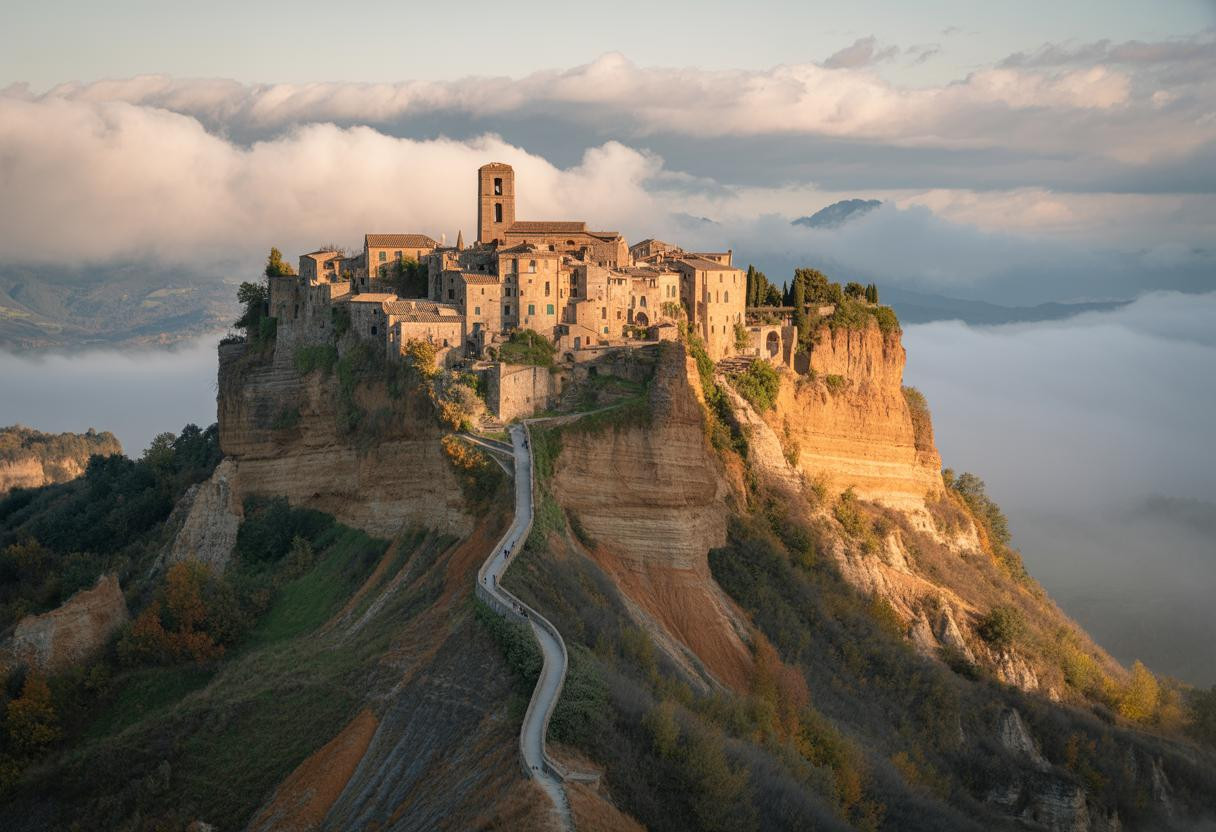Perched precariously on a crumbling cliff in central Italy, the medieval village of Civita di Bagnoregio captivates visitors with its fairytale appearance – but this extraordinary settlement is literally disappearing before our eyes. Founded by Etruscans over 2,500 years ago, this fragile treasure might not survive for future generations to enjoy.
A village suspended between heaven and earth
Accessible only by a 300-meter pedestrian bridge spanning a dramatic valley, Civita di Bagnoregio sits atop a plateau of volcanic tuff rock over soft clay – a geological combination that spells disaster. The steady erosion has earned it the somber nickname “La città che muore” (The Dying Town).
“Each significant rainfall accelerates the erosion process, making Civita’s future increasingly uncertain,” explains geological expert Marco Rossi. “What took nature thousands of years to build is disappearing at an alarming rate due to both natural processes and human activities like deforestation.”
From thriving community to living museum
While today Civita hosts just 7 permanent winter residents (expanding to about 100 in summer), its narrow cobblestone streets once bustled with life. The population decline began after a devastating earthquake in 1695, with families gradually relocating to more stable ground.
Unlike many Italian cultural sites that adapt to modern demands, Civita remains largely untouched – a medieval time capsule where even electricity arrived relatively recently.
A race against geological time
The battle to save Civita resembles an archaeological dig happening in reverse – instead of uncovering history, conservationists race to prevent it from vanishing. Every few years, sections of the cliff face collapse, taking pieces of history with them.
“After each collapse, we typically have two to ten years before the next one affects the same area,” notes Claudio Margottini from Italy’s Geological Survey. “It’s like watching a beautiful painting slowly fade – you can slow the process, but stopping it entirely may be impossible.”
Tourism: salvation or additional burden?
- Visitor numbers have increased from 40,000 to over 850,000 annually in recent years
- Tourism provides vital economic support for preservation efforts
- Additional foot traffic places further stress on fragile infrastructure
- Entrance fees (€5 on weekends) help fund ongoing stabilization work
Not the only wonder at risk
Like remote villages with unique preservation challenges, Civita faces an uncertain future. The same geological instability that threatens the town has actually preserved it from modernization – much as ancient natural formations often contain hidden benefits alongside their challenges.
“Visiting Civita is like walking through the pages of history. Every stone tells a story, every building whispers secrets of the past,” says cultural historian Elena Bianchi.
Worth experiencing while you still can
For travelers seeking authentic experiences beyond crowded tourist destinations, Civita offers a profound connection to Italy’s past. Like visiting museums that transform our perspective, standing in this vanishing village provides a unique emotional impact.
- Visit during shoulder seasons (April-May or September-October) for fewer crowds
- Arrive early morning or late afternoon for the most dramatic lighting
- Consider staying overnight to experience the village’s true character
Will science save this cosmic masterpiece?
Just as scientific tools reveal distant cosmic wonders, engineers employ cutting-edge technology to stabilize Civita’s foundations. Steel rods reinforce critical areas while sophisticated monitoring systems track minute movements in the cliff face.
Whether these efforts will ultimately save this extraordinary place remains uncertain. What is clear is that Civita di Bagnoregio stands as a breathtaking reminder of humanity’s temporary place in nature’s grand timeline – a fairytale village slowly returning to the earth from which it rose.
